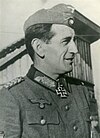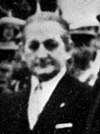Movimiento Nacional
| Part of a series on |
| Francoism |
|---|
 |
The Movimiento Nacional (English: National Movement) was a governing institution of Spain established by General Francisco Franco during the Spanish Civil War in 1937. During Francoist rule in Spain, it purported to be the only channel of participation in Spanish public life.[1] It responded to a doctrine of corporatism in which only so-called "natural entities" could express themselves: families, municipalities and unions. It was abolished in 1977.
Composition
[edit]The Movimiento Nacional was primarily composed of:
- The sole legal party, called Falange Española Tradicionalista y de las Juntas de Ofensiva Nacional Sindicalista (FET y de las JONS) which had been created at the beginning of the Spanish Civil War. Other parties were prohibited (the sole name of "party" was prohibited to design any type of organization).
- The sole trade union organization, called Organización Sindical Española (OSE, popularly known as the Sindicato Vertical), composed of corporatist organizations which gathered employers and workers, in opposition to Marxism's class warfare.
- All civil servants and holders of public office, who were requested to swear an oath to the Principles of the National Movement.
Leadership
[edit]The National Movement was led by Francisco Franco, titled Jefe del Movimiento (English: Chief of the Movement), assisted by a "Minister-Secretary General of the Movement". The hierarchy extended itself to all of the country, with a "local chief of the movement" named in each village.
Ideology
[edit]People who strongly identified with the Movimiento Nacional were colloquially known as Falangistas or Azules ("Blues"), from the colour of the shirts worn by the Falange Militia, José Antonio Primo de Rivera's fascist organization created during the Second Spanish Republic. Camisas viejas (Old shirts) enjoyed the honour of being historical members of the Falange, compared to Camisas nuevas (New shirts), who could be accused of opportunism.
The ideology of the Movimiento Nacional was summed up by the slogan ¡Una, Grande y Libre!, which stood for the indivisibility of the Spanish state and the refusal of any regionalism or decentralization, its imperial character, both past (the defunct Spanish Empire in the Americas) and foreseen (in Africa), and its independence towards the purported "Judeo-Masonic-Marxist international conspiracy" (a personal obsession of Franco), materialized by the Soviet Union, the European democracies, the United States (until the Pact of Madrid of 1953), or the "exterior enemy" which could threaten the nation at any time; as well as towards the long list of "internal enemies", like "anti-Spanish", "reds", "separatists", "liberals", "Jews" and "Freemasons", among others, coining expressions like "judeomarxistas".
Francoist "families"
[edit]Since one-party rule was enforced in Francoist Spain, the only practical expression of pluralism consisted in the mixture of internal "families" (Familias del Regimen) competing together inside the National Movement. These roughly included four "families" with a genealogy tracing back to the rightwing political groups in the interwar period: the Falangists (or azules, originally from the Fascist Falange Española de las JONS), with a preeminence over the FET y de las JONS, the Spanish Syndical Organization (OSE), and the "social" government areas; the traditionalists (issued from Carlism), who held a tight control over the Ministry of Justice; the monarchists (issued from Renovación Española and Acción Española), well connected to the economic elites and the military command; and the Catholics, "Catholics" in the sense of closely linked to religious entities under the Church hierarchy such as the Acción Católica or the Asociación Católica Nacional de Propagandistas (ACNP).[2] In addition, a new family emerged in the 1950s, the technocrats, conservatives linked to the Opus Dei who embraced a businesslike approach to the administration of the State.[2]
Franco held his power by balancing these internal rivalries, cautious not to show any favoritism to any of them nor compromise himself too much to anyone.
Fractions of those families eventually migrated to dissident stances. These included examples such as the intermittent dissent of a part of the Monarchists who vouched for an immediate coronation of Juan de Borbón as king, as well as sizeable part of the Catholic family joining by late francoism the opposition to the dictatorship subsumed within Christian democratic groups.[3]
Minister-Secretaries General of the Movement
[edit]| No. | Portrait | Name (Birth–Death) |
Term | Political party | ||
|---|---|---|---|---|---|---|
| Took office | Left office | Time in office | ||||
| 1 | Raimundo Fernández-Cuesta (1896–1992) | 4 December 1937 | 9 August 1939 | 1 year, 248 days | National Movement | |
| 2 | Agustín Muñoz Grandes (1896–1970) | 9 August 1939 | 16 March 1940 | 220 days | National Movement | |
| Position vacant (16 March 1940 – 19 May 1941) | ||||||
| 3 | José Luis de Arrese (1905–1986) | 19 May 1941 | 20 July 1945 | 4 years, 62 days | National Movement | |
| Position vacant (20 July 1945 – 5 November 1948) | ||||||
| (1) | Raimundo Fernández-Cuesta (1896–1992) | 5 November 1948 | 15 February 1956 | 7 years, 102 days | National Movement | |
| (3) | José Luis de Arrese (1905–1986) | 15 February 1956 | 25 February 1957 | 1 year, 10 days | National Movement | |
| 4 | José Solís Ruiz (1913–1990) | 25 February 1957 | 29 October 1969 | 12 years, 246 days | National Movement | |
| 5 | Torcuato Fernández-Miranda (1915–1980) | 29 October 1969 | 3 January 1974 | 4 years, 66 days | National Movement | |
| 6 | José Utrera Molina (1926–2017) | 3 January 1974 | 11 March 1975 | 1 year, 67 days | National Movement | |
| 7 | Fernando Herrero Tejedor (1920–1975) | 11 March 1975 | 12 June 1975 † | 93 days | National Movement | |
| (4) | José Solís Ruiz (1913–1990) | 13 June 1975 | 11 December 1975 | 181 days | National Movement | |
| 8 | Adolfo Suárez (1932–2014) | 12 December 1975 | 6 July 1976 | 207 days | National Movement | |
| 9 | Ignacio García López (1924–2017) | 7 July 1976 | 13 April 1977 | 280 days | National Movement | |
Electoral history
[edit]| Election | Leading candidate | Cortes Españolas | Government | |||
|---|---|---|---|---|---|---|
| Votes | % | Seats | +/– | |||
| 1967 | Francisco Franco | 564 / 564
|
Sole legal party | |||
| 1971 | 7,294,134 | 100.00 | 561 / 561
|
Sole legal party | ||
See also
[edit]- José Larrañaga Arenas
- Mottos of Francoist Spain
- Grand Council of Fascism, governing body of Fascist Italy
References
[edit]- ^ Payne, Stanley G. (2011-09-27). The Franco Regime, 1936–1975. University of Wisconsin Pres. p. 446. ISBN 9780299110734.
- ^ a b Gil Pecharromán, Julio (2019). La estirpe del camaleón. Taurus. pp. 39–41. ISBN 978-84-306-2301-3.
- ^ Gil Pecharromán 2019, pp. 40–41.











